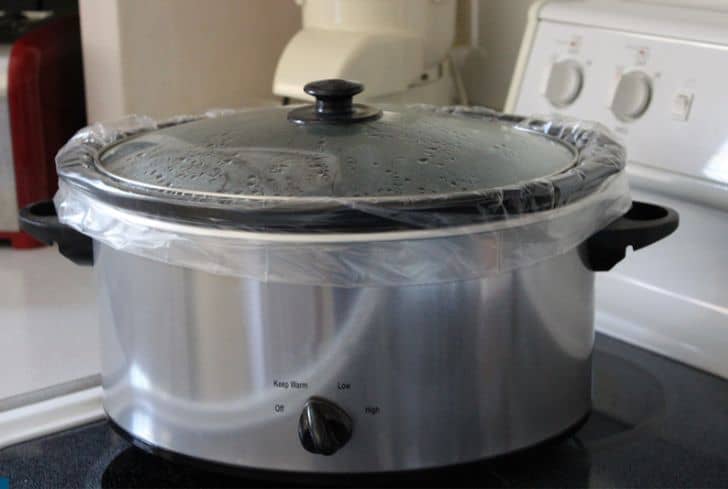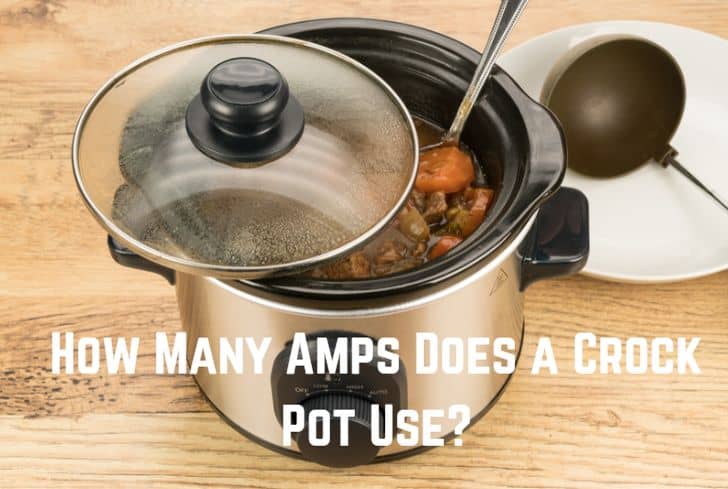Crock pots have been all the craze for the past few years. With this innovation, you can cook your food slowly and evenly without worrying about it burning or drying out. It’s one appliance that’s especially useful for those who have a busy lifestyle and don’t always have time to cook their meals from scratch.
It could be that you’ve heard all the hype and are convinced that adding one to your kitchen appliances would be a great move. However, since they cook for long hours, you still can’t figure out if they’ll significantly impact your home’s energy consumption. That brings the question – how many amps does a crock pot use?
Well, if all you want to know is your crock pot’s efficiency (or inefficiency) in relation to other home appliances, then you’re in luck. Herein, we have put everything there’s to know about this kitchen appliance. Let’s dive right in!
Read: How Many Amps Does a Dishwasher Use?
How Many Amps Does a Crock Pot Draw?
A crock pot will pull between 0.6 amps and 2 amps at 120 volts depending on the heat setting. When running on the average setting, a crockpot should use 175 watts. However, the lowest and highest setting will consume 70 watts and 240 watts, respectively.
As we began by saying, there are a lot of perks that come with using a crock pot. It’s a slow-cooking method that gives you ample time to complete other tasks without worrying about things going south in the kitchen.
That’s not all – crock pots are also a great way to save money on energy bills. Since they use less power than other common cooking methods, you’ll see a difference in your monthly consumption.
And usually, the amount of energy these handy kitchen appliances use depends on the heat setting they’re running at. A higher heat setting translates to more consumed power, while a lower heat setting does the opposite.
So, if your appliance is anything like the standard ones on the market, the amp draw will be between 0.6 and 2 – not a bad number at all. That translates to about 240 watts, assuming it’s running on high.
Perhaps you’re wondering what the three units – amps, watts, and volts – have in common and why we use them all when discussing crock pots. Well, the answer is simple – they all relate to electricity and the power it possesses.
Let’s spare a few minutes and look at how they are interconnected and how each differs from the other.
How Power Consumption is Measured (Watts, Amps, Volts)?
When you buy an electrical appliance, you usually see at least two of these units. And while some people use them interchangeably, they differ quite a bit. I’ll try and make the explanation as simple and straightforward as possible.
Let me use a simple example of a garden hose to explain the interconnection and the distinction between these units.
Water flows through a hose from the tap (or faucet) into your garden. But to flow, it needs some force to push it through, what we usually refer to as water pressure. The hose can only pass up to a certain amount of water depending on the diameter of the hose.
Suppose you’re with me to that point, great! You can easily understand the difference between the three basic units easily. So, let’s see how we can translate this into electrical terms.
The water pressure in our example is what we call voltage in electricity. Voltage is the force that drives the current (water in our example) through a conductor (hose). It is sometimes called electromotive force.
The current is what we call the amps, corresponding to the actual water flowing through the hose. It is a measure of how much electricity flows through a conductor at any particular time and is measured in amps. A higher amperage will need a thicker wire, the same way more water at any given time requires a broader hose.
Finally, wattage is a combination of voltage and amps. It measures the actual power consumption at a certain moment, i.e., how much water (amps) is flowing through the hose (wires) at a given pressure (voltage).
So, as you can see, all these three units are interconnected, and they all play an essential role in the world of electricity.
How Much Electricity Does a Slow Cooker Use Per Hour?
A slow cooker usually uses between 50 and 300 watts per hour, depending on the size of the slow cooker. Some, like those from Crock pots, are more efficient and will use barely above 200 watts when cooking with a high heat setting.
Since a slow cooker cooks just as the name suggests, slowly, it can take up to 8 hours for a meal to be ready. And when you first hear that a cooker is pulling power all this while, it’s normal to wonder just how much electricity it will have used up by the time you’re ready to sit down and eat.
Well, that all depends on the wattage of your slow cooker and how long it’s been cooking. But generally, these appliances will seldom cause any significant change in your monthly power consumption.
When running at a low setting, a slow cooker will consume about 70 watts per hour. Yes, it’s that efficient. But if you’re running on a higher setting, it’ll consume anywhere between 150 and 250 watts per hour! That’s a level of efficiency that’s hard to beat for a cooker.
So, assuming that you leave the slow cooker connected for 8 hours, that’s 0.560 kWh on low setting and at most 2 kWh if you go with the higher setting of 250 watts. That’s not a lot of power for a cooker.
Read: How Many Amps Does a Window AC Use
How Much Does It Cost To Run a Slow Cooker?
The amount it costs to run a slow cooker at a moderate setting of 150 watts is 1.95 cents per hour, assuming that a kWh costs $0.13. So, 8 hours of cooking at the same setting and rate translates to about 16 cents spent on electricity. On a higher setting of 250 watts, it’ll cost 3.25 cents for each hour of running and just 26 cents for 8 hours of cooking.
As you can see, among the most energy-efficient appliances anyone can add to their home is a slow cooker. In fact, this appliance is so efficient that it may have less impact on your energy bill than running some light bulbs.
Let’s assume that you’re using a 100-watt bulb in your kitchen. Leaving it on for an hour means 1.3 cents per hour, less than the 0.7 cents you’d spend per hour on a slow cooker running on a low 70-watt setting.
Do Crock Pots Use a Lot of Electricity?
No, crock pots don’t use a lot of electricity. In fact, crock pots are among the most efficient appliances you can have in your home. They’ll save you power, give you plenty of time to concentrate on your other tasks, and of course, deliver delicious food at the end of the day!
We’ve compared a slow cooker with a 100-watt bulb and seen that the former is the more efficient option. But how does this compare with other home appliances? Let’s take a more power-thirsty appliance such as a refrigerator this time.
Read: How Many Amps Does a Hot Tub Use?
The average fridge will use between 300 and 800 watts per hour. Let’s assume that you run the fridge for 8 hours a day. At the 300 watts setting, that’s 2.4 kWh; at the 800 watts setting, it’s 6.4 kWh.
Now, let’s compare this with the crock pot. Even at its highest setting of 250 watts, the crock pot will only use 2 kWh in 8 hours. As you can see, the crock pot is still a more efficient option.

Is It Cheaper To Use a Crock Pot or Electric Oven?
Obviously, it’s cheaper to use a crock pot than an electric oven. But speaking of cooking speed, the electric oven is much faster. So, while a crock pot delivers efficiency in power consumption, an electric oven gives you efficiency in time.
An electric oven runs between 2000 and 5000 watts and about 3000 watts on average. So, the electric oven will use 3 kWh in an hour of cooking. If you run it for 8 hours, that’s 24 kWh.
Using the average rate of $0.13 per kWh, it would cost $0.42 and $3.36 to run a 3000-watt electric oven for an hour and 8 hours, respectively. Of course, you will rarely need to run one for all this time. But, the thing is, there’s a significant price difference here.
What Size Inverter Do I Need To Run a Crock Pot?
The size of the inverter you need to run a crock pot depends on the size of your slow-cooking appliance. For a crock pot that uses 120 AC and draws power at 0.6 to 2 amps, an 1100-watt inverter should do the trick.
Like other appliances, inverters use AC power, the type of electrical power available in your home. But sometimes, when faced with power outages, we turn to alternative energy sources, which usually come in the form of DC power, such as batteries.
Now, to use an AC appliance like a crock pot with DC power, you need an inverter. This is a device that converts DC power into AC power. In general, the size of the inverter you need is proportional to the wattage requirements of your appliance.
As a general rule, you should get an inverter at least 1.25 times more than the wattage requirements of your crock pot. So, a 120-volt slow cooker that draws 2 amps will need at least a 1200-watt inverter to run smoothly for 4 hours. That’s assuming that it will be the only thing connected to the power source.
The reason for having a higher wattage inverter than the actual wattage load is because no inverter is 100% efficient. As such, there will always be some heat loss and other inefficiencies, so we add the 25% allowance to be on the safe side.
Can a Crock Pot Be Left on Low All Night?
Yes, you can leave a crock pot on low all night as long as the appliance is in tip-top condition. Crock pots are designed to operate without any problems for long hours, so you can set it before going to bed and have your food ready when you wake up.
Of course, this assumes that your crock pot is in good working condition. If you’ve recently noticed a few issues with it, such as shorter cooking times or uneven heating, then it’s best not to take the risk.
But again, even if you have to leave it overnight, it has to be on a low setting. That way, you can avoid any accidents from leaving it on for too long. If you can, wake up and check on it every few hours just to be on the safe side.
Read: How Many Amps Does a Microwave Use?
Final Thoughts
A crock pot is a very efficient way to cook your food. Not only does it use less energy than an electric oven and most other appliances, but it also helps retain the nutrients in your food better.
So, if you’re looking for an appliance that can help you save on your energy bill and still deliver delicious food without having to keep a close eye on it, then a crock pot is the way to go. Just remember to always read the manufacturer’s instructions on how to use it properly and safely.






